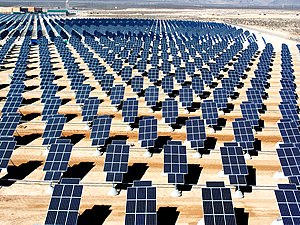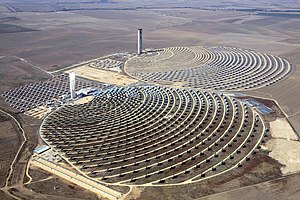| English: On 140 acres of unused land on Nellis Air Force Base, Nev., 70,000 solar panels are part of a solar photovoltaic array that will generate 15 megawatts of solar power for the base. (Photo credit: Wikipedia) |
First lets look at what we are using currently to meet our power needs, fossil energy and atomic power, and how ecologically damaging they are.
To start, most existing fossil energy launch many different poisons directly into the air we breathe, from sulfur to lead and mercury. Even the newer powerplants coming online, which decrease poisons dramatically, still generate massive amounts of CO2, a natural house gas and a direct cause of climatic change. Natural gas is far more harmless but still produces bulk of CO2 when used to generate power. How much CO2 is launched - a 5-kilowatt solar power program will prevent the discharge of nearly 10,400 weight of CO2 every season for the lifestyle of the program. The common home uses 8,000-kilowatt hours per season. A fossil energy power place generating that much power produces about 18,000 weight of CO2 per season.
When fossil energy is burned, co2, sulfur dioxide, nitrogen oxides, and mercury compounds are launched. For that reason, coal-fired boilers are required to have control devices to decrease the quantity of pollutants that are launched. Exploration, cleaning, and transporting fossil energy to the power place generate additional pollutants. For example, methane, a potent natural house gas that is trapped in the fossil energy, is often venting during these processes to increase safety.
Secondly, bulk of the water are needed to eliminate impurities from fossil energy at the mine. These bulk of the water are used for generating vapor and to chill techniques. When coal-fired power vegetation eliminate the water from a pond or stream, the seafood and other marine lifestyle can be impacted, as well as animals and people who depend on these marine sources. At the same time, contaminants develop up in the the water used by the power place boiler and air conditioning. If the the water used in the power place is released to a pond or stream, the contaminants in the the water can harm vegetation and seafood.
| English: PS20 and PS10 in Andalusia, Spain (Photo credit: Wikipedia) |
Last, the burning of fossil energy creates strong spend, called ash, which is composed primarily of metal oxides and alkali. On regular, the ash content of fossil energy is 10 percent. Solid spend is also created at fossil energy mines when fossil energy is cleaned and at power vegetation when air contaminants are removed from the stack gas. Much of this spend is deposited in landfills and abandoned mines, although some amounts are now being recycled into useful products, such as cement and building materials.
So, you may say, what about atomic power? While atomic power vegetation do not release co2, sulfur dioxide, or nitrogen oxides - fossil energy pollutants are associated with the uranium mining and uranium enrichment procedure as well as the transport of the uranium energy to the atomic place. Nuclear power vegetation also use bulk of the water for vapor production and to chill. When atomic power vegetation eliminate the water from a pond or stream, seafood and other marine lifestyle can be impacted. Water contaminants, such as pollutants and salt develop up in the the water used in the atomic power place techniques. These the water contaminants, as well as the higher the water temperature released from the power place, can negatively affect the water quality and marine lifestyle.
Waste produced from uranium mining operations and rainwater run-off can contaminate groundwater and surface the water sources with pollutants and records of radioactive uranium. Every 18 to 24 months, atomic power vegetation must shut down to replace the "spent" uranium energy. This invested energy has launched most of its power as a result of the fission procedure and has become radioactive spend.
All of the atomic power vegetation in the United States together generate about 2,000 measurement tons per season of radioactive spend. Currently, the radioactive spend is stored at the atomic vegetation at which it is produced, either in steel-lined, tangible containers filled with the water or in above-ground metal or steel-reinforced tangible containers with metal inner containers. This spend will remain radioactive for many centuries.
As you can see, the more solar power is used, the more it allows our atmosphere. By making an investment in solar power these days you are making an investment in your upcoming and your children's upcoming and you do this by fighting climatic change and decrease our nation's dependence of foreign types of. And, you are helping in the reduction of CO2 pollutants and protecting clean rivers. It's amazing how such a small change in one's lifestyle can do so much.
Visit here for a complete collection of breeze generators and solar power panel technology solutions. Think natural.


